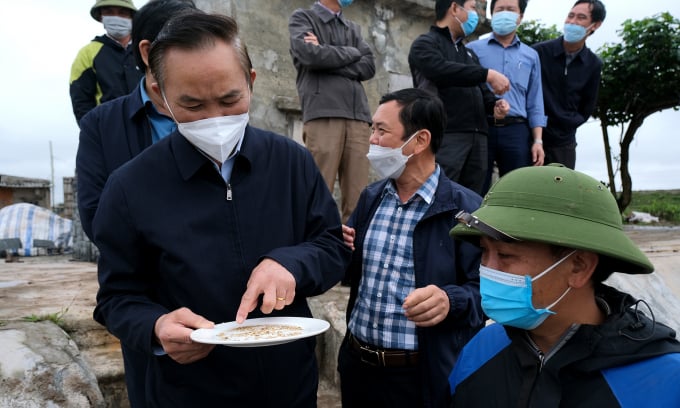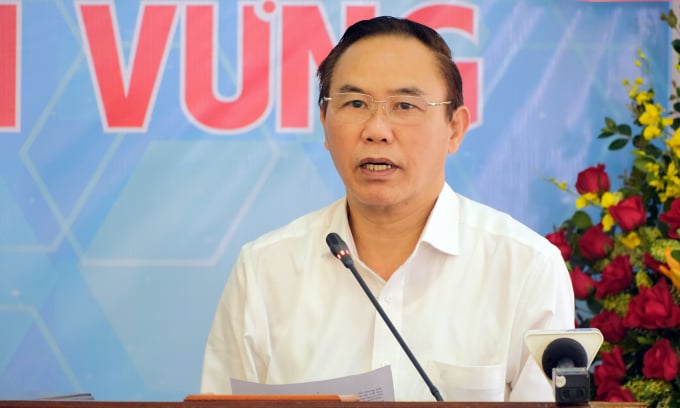November 28, 2025 | 01:27 GMT +7
November 28, 2025 | 01:27 GMT +7
Hotline: 0913.378.918
November 28, 2025 | 01:27 GMT +7
Hotline: 0913.378.918

Deputy Minister Phung Duc Tien inspecting a clam hatchery in the Northern region. Photo: Bao Thang.
Speaking at the Sustainable Mollusk Industry Development Forum in Nam Dinh on April 6, Deputy Minister of Agriculture and Rural Development Phung Duc Tien highly appreciated the role of the mollusk industry in the development of the seafood industry in particular and agriculture in general.
Information from the Directorate of Fisheries shows that in 2021 the total mollusk output is estimated at over 300,000 tons. Bivalve mollusks have been exported to over 67 markets around the world with a turnover of over VND 125 million, an increase of over 20% compared to 2020.
However, according to Ms. Dang Thi Lua, Deputy Director of the Research Institute for Aquaculture I (RIA1), mollusk farming still possesses certain limitations.
Thanks to the application of environmental technology for effective aquaculture management, RIA1 warns that the environment in mollusk farming areas is showing signs of deterioration. In recent years, especially from July to August and from October to March, farming areas often witness mass mortality of clams due to the main reason being high stocking density combined with the abnormal fluctuations of salinity and infection of pathogens in clams.
It’s within expectations that the mollusk industry will continue facing many difficulties and challenges in 2022, such as a decline in resources, instability in seed quality, and the market’s increasing demands on food safety. the product size remains unstable in many places and production areas, and the meat/shell ratio is low because the breed shows signs of genetic degradation.
In response to the situation, Ms. Hoang Thi To Nga, Deputy Director of Nam Dinh Department of Agriculture and Rural Development, said that the province has implemented a food safety control program in consideration of the harvesting of bivalve mollusks since 2009. Two farming areas of Nam Dinh are allowed to harvest and supply raw materials for export processing at the moment.
Nam Dinh will continue to promote the safe clam production and consumption chain in the direction of increasing added value and sustainable development; expand sustainable ASC-certified clam farming areas; apply new scientific technology to develop clam production and consumption link chain in the locality.
Fully aware of the present difficulties and obstacles, Deputy Minister Phung Duc Tien said that mollusk products in the industry had many good opportunities for future development such as a total water surface area of up to 1 million hectares; a total coastline of 3,260km; all levels, sectors and localities in Vietnam strongly shifting the mindset from “agricultural production” to “agricultural economy”.

Deputy Minister Phung Duc Tien speaking at the Sustainable Mollusk Industry Development Forum in Nam Dinh on April 6. Photo: Bao Thang.
The Deputy Minister assigned the Directorate of Fisheries to effectively implement the provisions of the Law on Fisheries 2017 in seed production and commercial farming of mollusks that hold economic value; organize the implementation of the tasks of managing aquaculture conditions and monitoring the aquaculture environment in mollusk farming areas.
As for the Agro Processing and Market Development Authority, the Deputy Minister demanded more proactive actions, regular assessment of market developments and prompt information so that people can know about the present situation and have an appropriate production plan. The unit was also requested to identify valuable processed mollusk products that suit the tastes of consumers and include them in trade promotion activities. This was also one of the authority’s priorities.
The Department of Animal Health and the National Agro-Forestry-Fisheries Quality Assurance Department needed to strengthen quarantine and disease control in seed production, commercial farming, quality control and food safety. This would become the basis for building and developing breeding facilities and disease-free mollusk farming areas as well as ensuring product traceability.
Regarding localities, businesses, industry associations and people, the leader of the agriculture sector proposed the continuation of evaluations and supplement of nurturing areas in accordance with MSC standards. Establishments needed to cooperate and link production in chains to reduce intermediaries and production costs while improving product quality. It was also essential for units participating in the mollusk production link chain to apply certified farming methods (VietGAP, GlobalGAP, ASC) to improve product value.
Translated by Samuel Pham

(VAN) According to Mr. Vo Minh Thanh, Director of the Tay Ninh Department of Agriculture and Environment, Resolution 57 has created a new development pathway for the locality, shifting from traditional toward modern agriculture.
/2025/11/26/4909-2-154329_878.jpg)
(VAN) Pearl grouper farming in HDPE cages not only delivers economic efficiency but also contributes to protecting the environment, creating jobs, and promoting marine-based experiential tourism.

(VAN) The model of making a living under the forest canopy through the agroforestry system in Van Son commune, Bac Ninh province, is expected to generate an annual income of approximately VND 30 million/ha.

(VAN) Many enterprises in Can Tho are harnessing natural energy and reducing greenhouse gas emissions in their production processes, thereby contributing to the promotion of a sustainable green transition.
/2025/11/24/3536-2-112800_176.jpg)
(VAN) Dong Nai now has tens of thousands of hectares of forests certified for sustainable management, and this area will continue to be expanded in the coming period.

(VAN) Vinh Ha hamlet (Dai Xuyen commune, Hanoi) is shifting away from small-scale farming as households adopt bioscurity into their breeder chicken models.

(VAN) Heavy rains make aquatic species more vulnerable to disease. Proactive water management and high-tech systems help farmers prevent outbreaks and protect yields.